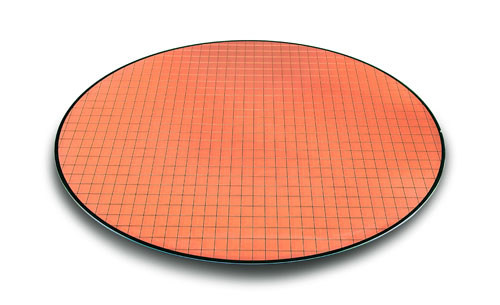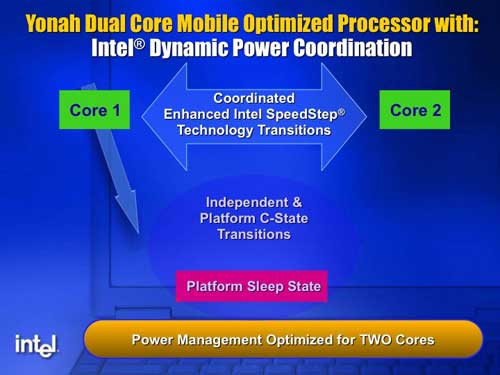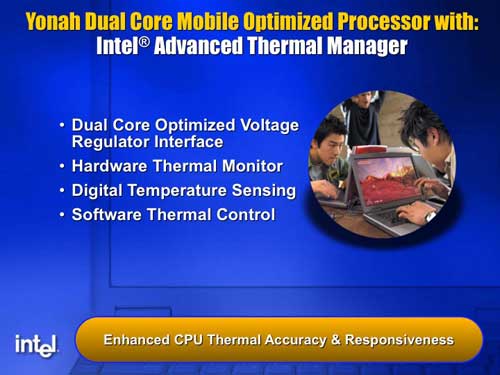Intel's Core Duo Launch - Notebook Performance Revealed
by Anand Lal Shimpi on January 5, 2006 8:00 PM EST- Posted in
- Laptops
CPU-Level Power and Thermal Enhancements
Back in March Intel's Mooly Eden told us that despite the move to two cores and almost doubling the transistor count of Dothan, Yonah notebooks would offer battery life no shorter than Dothan notebooks. In other words, you'd get all of the performance benefits of dual core but with no power consumption penalty.
While we noted that, at least on the desktop side, both the Athlon 64 X2 and Pentium D provided us with dual core performance but with only an additional 15% increase in power consumption. So it wasn't too far fetched to believe that, with enough effort, you could move to dual core, increase performance and not increase power consumption.
At the same briefing where they told us that they would keep power consumption the same, Intel also told us how they'd do it:
From the first time we heard the name Yonah we knew that its designers would be introducing some interesting power management technologies. While we don't normally like filling articles with quotes, here's one from Mooly today that is a great segue into this section:
"Yonah battery life will not be shorter than Dothan battery life...[it's] a huge achievement"
Given that Yonah will have twice the decode/execution transistors of Dothan, offering equal battery life for Yonah notebooks is a pretty impressive claim.
Mooly went through some of the power management technologies in Yonah that Intel is calling Dynamic Power Coordination. The idea is this - there are some areas where you can have each core operate independently with regards to reducing power consumption, but other areas where you can't.
Dothan has five operating states:
C0 - full power
C1 - auto halt (less power)
C2 - stop clock (even lower power)
C3 - sleep (lower power)
C4 - deep sleep (still lower)The CPU's goal is to complete the tasks it's given, while always striving to be in as low of a power state as possible. So for example, if a Dothan is running an application that doesn't require full performance, it can operate in one of the lighter power saving states until it is done working, then eventually drop all the way down to C4.
The lighter power saving stages just do things like reduce clock speed or gate the clocks to parts of the chip, these types of things can be done independently on each core in Yonah (e.g. one core can be in C1 while the other core is in C0). Once you get down to adjusting voltage and playing with the PLL, then the two cores can't act independently - since they are both fed the same voltage and clock signal. Here is where Intel's Dynamic Power Coordination comes into play; if one CPU wants to go to a lower power state (e.g. C3 or C4) but the other core is running at C0, it will inform Intel's DPC logic of the current situation. Intel's logic, as you would expect it to act, will wait until the core running in C0 is done working and then move both cores down to the lower power state. Synchronization like this is important and it helps keep power consumption down to a minimum.
Because of the power management that is needed for Yonah, the two cores have to always work closely together to make sure that they are aware of each other's power state desires - for this reason alone Yonah is already much more than a pair of Dothans with a shared cache.
Yonah also introduces finer grained thermal management through what they are calling the Advanced Thermal Manager. With dedicated digital thermal sensors in each core, each with a higher accuracy, the temperature data the CPU can feed the rest of the system is more accurate in Yonah than in previous generation Pentium M CPUs. Although Mooly didn't talk about it here, you can expect that the thermal management technology in Yonah will allow for one core to be slowed down independently of the other if power consumption or heat dissipation rises too much.
The one item that isn't mentioned, but is quite responsible for the excellent thermal and power characteristics of Intel's Core Duo is the 65nm manufacturing process it is built on.

A Yonah wafer
Intel's 65nm process is ramping up nicely and is extremely cool running and very low power. Combine it with the power management technologies talked about above and you can see how the move from Dothan to Yonah wouldn't negatively impact power consumption.












29 Comments
View All Comments
OvErHeAtInG - Saturday, January 7, 2006 - link
You hit the nail on the head. The increased power consumption would not be worth it. And IIRC was pointed out in the article, higher memory freq would provide a really minimal performance increase since the FSB is already lower bandwidth than that.psychobriggsy - Friday, January 6, 2006 - link
Did anyone else notice the strange mention of three compaq laptops on page 13 IIRC of the review?Anyway, this looks like a good product from Intel which will keep them ahead in mobile areas for the foreseeable future. AMD may catch up of course, but we will see what they offer later this year. I'm sure that revision F will be good though, and DDR2 will reduce power consumption on AMD notebooks a bit more.
Stolichnaya - Friday, January 6, 2006 - link
Looks like the 'i' is going to crash on it's left side any time...nserra - Friday, January 6, 2006 - link
You are all dreaming here, thinking that amd can release a processor (platform) as good as this for the notebook area. The only extra is the 64 bit.They lack all the others, and primary ones:
-Good platform from one of their partners.
-Low power chipset to couple with the processor.
-Brand recognition....
nidomus - Monday, January 9, 2006 - link
coughfanboycoughBrucmack - Friday, January 6, 2006 - link
I'm normally not a spelling nazi, but this is the second time I've seen this on Anandtech, and it's really annoying...On page 5, the word you're looking for is "segue", not "segway".
Shark Tek - Thursday, January 5, 2006 - link
Great package but I don't have money for it :(http://www.pcmag.com/article2/0,1759,1908402,00.as...">Dell Inspiron E1705
Type: Gaming, General Purpose, Media
Operating System: MS Windows XP Media Center
Processor Name: Intel Pentium M T2500
Processor Speed: 2 GHz
RAM: 1024 MB
Hard Drive Capacity: 80 GB
Graphics: nVidia GeForce Go 7800GTX
Primary Optical Drive: Dual-Layer DVD+/-RW
Wireless: 802.11a/g
Screen Size: 17 inches
Screen Size Type: widescreen
System Weight: 8.2 lbs
Calin - Friday, January 6, 2006 - link
But that isn't a portable laptop, is a towable one :(Shark Tek - Thursday, January 5, 2006 - link
That power consumption will be equal or better than previous Pentium-M generation. Now lets wait for AMD what they have to offer when they launch the Turion64 X2.They wont be sufficient to compete with "Core Duo" the only real advantages over intel are 64 bit support and cheaper cpu prices, nothing else.
Intel will leap forward a few more years in the mobile market.
Viditor - Thursday, January 5, 2006 - link
Keep in mind that you're just making an "enthusiastic guess" here...
AMD has started a new process of strained silicon on their 90nm chips which is specifically targeted at reducing power and increasing effeciency.
These are released in new steppings rather than new architectures (remember Rev E cut power requirements in half compared to previous generations of 90nm chips).
Even more important is the platforms...remember that the Turion isn't even 1 year old, and the platform designs are still minimal at best. It would be foolish to discount AMD at this point.
That said, Intel deserves hearty congratulations on the duo and it's platform! 2006 is going to be an interesting year...!